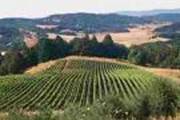
9TH ANNUAL
PINOT NOIR SHOOTOUT
PASSION FOR PINOT
2010 CABERNET SAUVIGNON SHOOTOUT
8TH ANNUAL
PINOT NOIR SHOOTOUT
PASSION FOR PINOT
2009 CABERNET SAUVIGNON SHOOTOUT
7TH ANNUAL
PINOT NOIR SHOOTOUT
PASSION FOR PINOT
2008 CALIFORNIA-AUSSIE SHOOTOUT
6TH ANNUAL
PINOT NOIR SHOOTOUT
2007 CABERNET SAUVIGNON SHOOTOUT
5TH ANNUAL
PINOT NOIR SHOOTOUT
4TH ANNUAL
PINOT NOIR SHOOTOUT
3RD
ANNUAL
PINOT NOIR SHOOTOUT
2004 CABERNET SAUVIGNON SHOOTOUT
8th Annual Pinot Noir Shootout
&
Summit Results
GROWING PINOT NOIR
The Grape. Growing great Pinot Noir fruit is a challenge. Pinot Noir is not difficult to grow when planted on the right site, but the right site is difficult to find. Pinot Noir is thin-skinned and tight- clustered, so it is vulnerable to downy and powdery mildew and bunch or grey rot. Pinot Noir has all the frailties of a delicate white grape. It has far fewer phenolics and less color and tannin than many international grape varieties, except perhaps Grenache. It buds early, so it is susceptible to both spring frosts and coulure, or shatter – the non-pollination of vine flowers and the resulting halt in grape development – leading to millerandage, also called “hens and chicks”. One of the more limiting factors is the relatively small window for ideal ripeness. If the growing conditions are too cool, Pinot Noir never fully ripens and lacks color; too hot and the flavors become jammy and stewed. Only a few places on earth are capable of producing high-quality wine from this grape. Cooler, more marginal sites allow Pinot Noir to attain full ripeness in terms of sugars, phenolics, and varietal flavors.
 The Vineyard. The best soil profile for Pinot Noir is well drained, chalky clay, but it also fares well in marl loam. It is generally moderate in vigor and has low productivity. The vine bears small, compact clusters of not very thick skinned berries which are high in acid, moderate in tannin, not very deep in color and delicately scented. What color Pinot Noir has can drop out during careless vinification. Pinot Noir seems to reflect more pronounced gout de terroir, or flavor of the soil, than other black grape types, making vineyard site selection a critical factor In Burgundy. The unique presence of a mineral called montmorillonite, is said to facilitate the Pinot Noir plant’s absorption of elements from the soil, which may be one of the reasons why red Burgundies so precisely reflect their microclimates. For most wine regions, superb Pinot Noir is simply out of the realm of possibility. Cool Oregon and coastal California are two places in America where that possibility exists.
The Vineyard. The best soil profile for Pinot Noir is well drained, chalky clay, but it also fares well in marl loam. It is generally moderate in vigor and has low productivity. The vine bears small, compact clusters of not very thick skinned berries which are high in acid, moderate in tannin, not very deep in color and delicately scented. What color Pinot Noir has can drop out during careless vinification. Pinot Noir seems to reflect more pronounced gout de terroir, or flavor of the soil, than other black grape types, making vineyard site selection a critical factor In Burgundy. The unique presence of a mineral called montmorillonite, is said to facilitate the Pinot Noir plant’s absorption of elements from the soil, which may be one of the reasons why red Burgundies so precisely reflect their microclimates. For most wine regions, superb Pinot Noir is simply out of the realm of possibility. Cool Oregon and coastal California are two places in America where that possibility exists.

The Wine. There is nothing quite like a great Pinot Noir. But great Pinot Noir comes in various guises. It can be delicate with red berry or cherry aromas with baking spice, citrus or mushroom accents. Or it can be intense with a ripe black cherry aroma, accented by spice and forest floor notes. Its weight on the palate can range from light and elegant to full-bodied but always with a certain soft, velvet texture. Depending on the winemaking, Pinot Noir may be immediately approachable or require extended aging. In short, great Pinot Noir can be many things, but it always has substantial flavor, even in its most delicate variant.
For more in-depth information on growing and making Pinot Noir, as well as extensive tasting notes on Pinot Noir wines, see the IWR reports #7, New Zealand’s Exciting Pinot Noirs, #16, Oregon Pinot Noir, and #20, Wines of the Santa Lucia Highlands, as well as tasting articles at iwinereview.com.